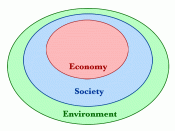In 2002, the global community held the World Summit on Sustainable Development in Johannesburg. Look into any current issue in the realm of environmental science and undoubtedly you will come across the term sustainability. Sustainability and sustainable development have made their way into the environmental lexicon in full force. Sustainable development is the balancing of social and economic development with environmental protection. It is a paradigm shift from striving to minimize waste to creating absolutely no waste. Three pillars of sustainable development have come to be known as people, prosperity, and planet. A sustainable society continues to advance socially and economically without compromising the ability of future generations to do the same.
Most agree that science and engineering are the key to creating a sustainable society. Scientific discovery leads to new technologies that may aid in sustainable development. However, this does not necessarily imply a linear path. Ideally, better scientific knowledge leads to technological innovation, which in turn leads to industrial innovation.
It is quite common for this sequence to occur out of order. Take for example the steam engine. James Watt invented the steam engine well before the laws of thermodynamics were understood. Still to this day the steam engine and heat cycles are used to teach thermodynamics. So, pure science cannot be relied upon solely to create a sustainable world.
Ironically, it is often new technology and industrial innovation that create barriers to sustainability. Modern derivatives of Watt's engine are used to heat and power the world. They are at the heart of our electricity and vehicles, yet they are among the biggest polluters of the planet. Most importantly, they compromise the long term viability of our biosphere. Most often, is the second order effects of technology that are so harmful. It is not the steam engine...


